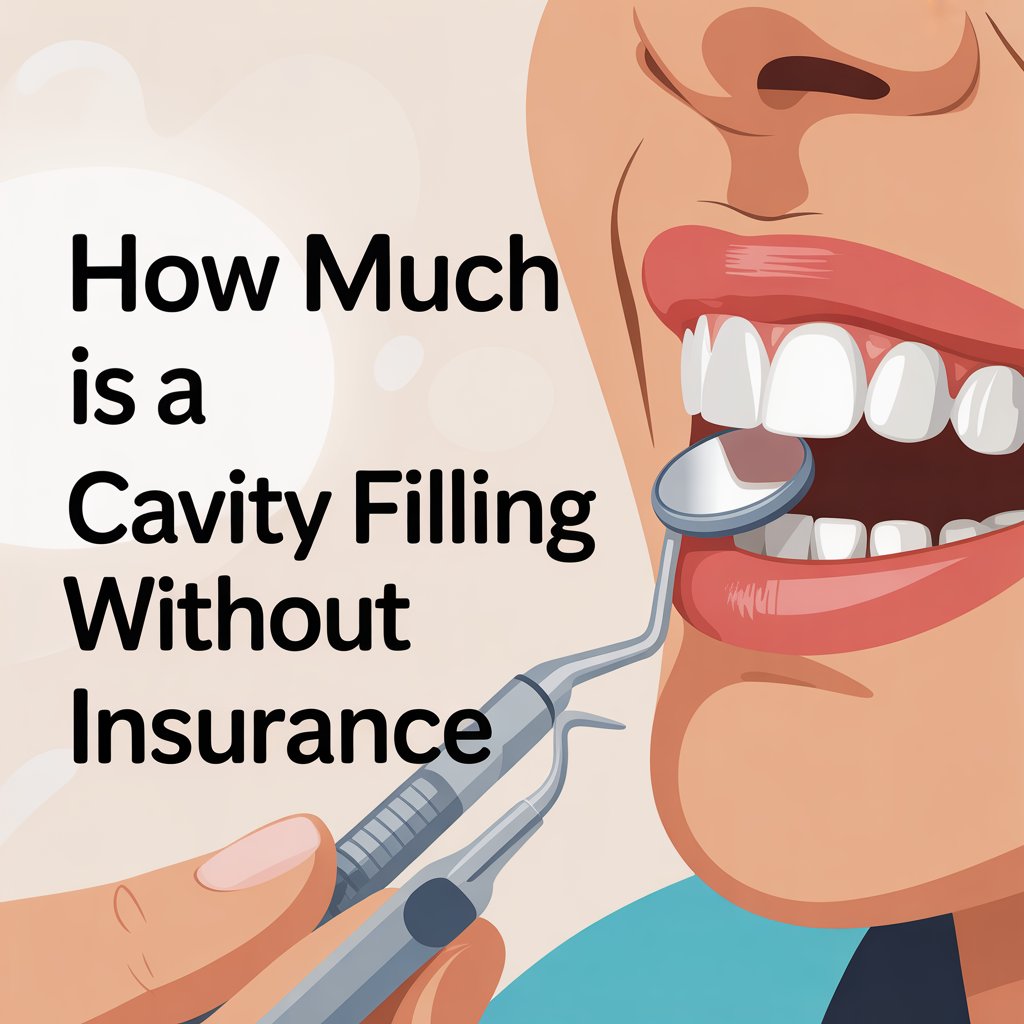How much is a cavity filling without insurance? This is one of the most common and pressing questions for anyone dealing with dental issues while lacking coverage. Tooth pain can be unbearable, and untreated cavities can lead to serious complications, including infections, tooth loss, or even more expensive treatments like root canals. However, the fear of high dental bills often leads people to delay care—sometimes until it’s too late.
In this article, we’ll explore the full cost of cavity fillings in the United States for uninsured patients, including the various types of fillings, what influences pricing, and how you can reduce out-of-pocket expenses. Whether you’re comparing quotes or trying to understand your options, this guide will provide clarity, realistic expectations, and actionable tips for getting dental care without breaking the bank.
Understanding the Basics: What Is a Cavity Filling?
A cavity filling is a dental procedure used to restore a tooth damaged by decay back to its normal function and shape. The dentist removes the decayed portion of the tooth, cleans the affected area, and then fills the cleaned-out cavity with a filling material.
Fillings not only repair the damage but also prevent further decay by closing off spaces where bacteria can enter. They’re a routine and effective solution for most early-stage cavities.
The most common types of filling materials include:
- Composite (tooth-colored) fillings
- Silver amalgam fillings
- Gold fillings
- Ceramic fillings
- Glass ionomer fillings
The material you choose plays a significant role in determining how much does a cavity filling cost, especially if you’re paying out-of-pocket.
How Much Is a Cavity Filling Without Insurance?
Let’s address the main question: how much is a cavity filling without insurance?
On average, the cost of a cavity filling in the United States ranges from $100 to $500 per tooth—and that price can go even higher depending on factors such as location, the type of material used, and the severity of the decay.
Here’s a general cost breakdown by filling type (for one tooth):
| Filling Type | Estimated Cost Without Insurance |
|---|---|
| Silver Amalgam | $100 – $250 |
| Composite Resin | $150 – $400 |
| Ceramic/Porcelain | $300 – $1,000 |
| Gold Fillings | $500 – $1,500 |
| Glass Ionomer | $100 – $300 |
These prices reflect standard dental clinic rates in urban and suburban areas. In rural regions or community dental programs, costs may be lower. However, in high-cost cities or private clinics, fees may be significantly higher.
Factors That Influence Dental Filling Cost
The dental filling cost doesn’t come with a flat rate for everyone. Several variables can affect how much you’ll pay:
1. Filling Material
As shown above, the choice of material is a major factor. Silver amalgam is cheaper, but not as aesthetic. Composite is more natural-looking but more expensive.
2. Tooth Location
Front teeth are easier to access and often less costly to fill. Molars, which are harder to reach and more complex to treat, can cost more.
3. Cavity Size and Depth
Larger or deeper cavities may require more extensive treatment or multiple layers of filling material, which increases the price.
4. Dentist’s Experience and Location
Clinics in major cities often have higher overhead costs, which translates into higher dental fees. Additionally, well-known or highly experienced dentists may charge more for their services.
5. X-rays and Diagnostic Costs
Initial appointments typically include x-rays, exams, and consultation. These can add $50–$200 to the total cost, depending on your location.
6. Additional Procedures
If your tooth requires extra cleaning, numbing, or prep work, these procedures can increase the final bill. In some cases, if the decay is extensive, your dentist may recommend a crown or root canal—both of which are significantly more expensive.
Comparing Costs: Private Clinics vs Community Clinics
If you don’t have dental insurance, comparing your options becomes crucial.
Private Dental Clinics
Pros:
- Faster appointments
- Personalized service
- Newer equipment
Cons:
- Higher costs
- Less likely to offer payment plans
Community Dental Clinics or Dental Schools
Pros:
- Lower costs or sliding-scale fees
- Supervised care by student dentists
Cons:
- Limited availability
- Longer wait times
- Restricted treatment hours
If you live in areas like Florida, you can explore options like Dental Services in Hallandale Beach, where some providers may offer special rates for uninsured patients or discounts through dental savings plans.
How Much Is It to Fill a Cavity Without Insurance?
For uninsured individuals asking, how much is it to fill a cavity without insurance, the out-of-pocket cost per filling usually ranges from $100–$400. The cost can rise if:
- Multiple teeth are affected
- X-rays or consultations are billed separately
- The dental clinic is located in a high-cost metro area
- Specialized filling materials like ceramic or gold are chosen
Patients with multiple cavities may face a bill between $500 and $2,000 without insurance.
Why You Shouldn’t Delay Treatment
It’s tempting to put off dental care when money is tight, but waiting can be a costly mistake. What starts as a small cavity may grow into a severe infection requiring root canal treatment or even tooth extraction.
Root canals typically cost $700 to $2,500 per tooth, and crowns can add another $800 to $1,200. Compared to a simple filling, these costs are exponentially higher.
Moreover, untreated dental decay can lead to pain, bad breath, abscesses, and in rare cases, life-threatening infections.
Payment Alternatives and Discount Options
There’s good news: even if you’re uninsured, several options can make cavity fillings more affordable.
1. Dental Discount Plans
These are membership-based programs that offer reduced rates at participating dentists. Plans cost around $100–$200 per year, and savings range from 20%–50% off standard fees.
2. Flexible Spending Accounts (FSA) or Health Savings Accounts (HSA)
If you have an FSA or HSA through your employer or bank, you can use these tax-free funds to pay for dental procedures, including fillings.
3. CareCredit and Payment Plans
Some clinics offer interest-free installment plans or accept medical credit cards like CareCredit to spread out payments over several months.
4. Dental Schools
Dental colleges offer low-cost fillings performed by student dentists under faculty supervision. Though it takes more time, the quality is often comparable to private clinics.
5. Community Health Clinics
Federally Qualified Health Centers (FQHCs) and nonprofit clinics often provide sliding-scale dental care based on your income.
What to Expect During a Filling Procedure
Here’s a step-by-step outline of what happens when you get a cavity filled:
- Exam and Diagnosis
The dentist identifies the cavity through a visual exam or X-ray. - Numbing
Local anesthesia is applied to the affected area to ensure comfort. - Decay Removal
The dentist removes decayed material using a drill or laser. - Tooth Cleaning
The area is cleaned to remove bacteria and debris. - Filling Placement
The chosen material is applied in layers and hardened using a special light. - Shaping and Polishing
The dentist shapes and polishes the filling to match your bite.
Most procedures take 30–60 minutes and allow you to return to your day with minimal downtime.
How Much Does a Cavity Filling Cost Compared to Other Procedures?
To put things in perspective, here’s how filling costs stack up against other common dental procedures (without insurance):
| Procedure | Average Cost Per Tooth |
|---|---|
| Basic Filling | $100–$400 |
| Root Canal (front tooth) | $700–$1,200 |
| Root Canal (molar) | $1,000–$2,500 |
| Dental Crown | $800–$1,500 |
| Tooth Extraction | $150–$600 |
| Dental Implant | $3,000–$5,000 |
Clearly, catching cavities early and filling them promptly can save you thousands of dollars.
Can You Get Emergency Dental Work Without Insurance?
Yes. Many dental clinics offer emergency care to uninsured patients, especially for infections, pain, or broken teeth. However, be aware that emergency fees can be higher due to priority scheduling or after-hours services.
Before you go, ask:
- Do you offer upfront cost estimates?
- Are payment plans available?
- Can you perform a temporary fix until I can afford the full treatment?
Even in emergencies, your financial rights matter.
Preventing Future Cavities
Good dental hygiene can help prevent cavities—and costly fillings—in the future. Here are essential habits:
- Brush twice daily with fluoride toothpaste
- Floss every day
- Avoid sugary snacks and sodas
- Visit the dentist every 6 months for cleanings and checkups
- Use dental sealants if recommended
Preventative care costs a fraction of what corrective care does—and it keeps your smile intact.
Final Thoughts: How Much Is a Cavity Filling Without Insurance?
So, how much is a cavity filling without insurance? The typical cost ranges from $100 to $500 per tooth, depending on the material, location, and severity. It’s an investment in your health that can prevent far more expensive procedures down the line.
If you’ve been wondering how much is it to fill a cavity, or whether treatment is even possible without dental insurance, the answer is clear: yes, it’s doable—and affordable—if you explore community resources, discount plans, and alternative payment methods.
For those in Florida, local options like Dental Services in Hallandale Beach may offer tailored support, especially for those navigating care without coverage.
Your oral health deserves attention, even when budgets are tight. Don’t wait for the pain to become unbearable. Act early, ask questions, and prioritize your long-term wellness.
FAQs
How much does a cavity filling cost on average?
On average, a cavity filling costs between $100 and $500 per tooth depending on the material used, the size and location of the cavity, and the dentist’s location and experience.
What is the cheapest type of dental filling?
Silver amalgam fillings are typically the cheapest, often ranging from $100 to $250 per tooth. They’re durable but less aesthetic compared to tooth-colored options.
How much is it to fill a cavity without insurance?
If you’re wondering how much is it to fill a cavity without insurance, you can expect to pay anywhere from $100 to $400 per tooth, depending on the extent of the decay and the materials used.
Can I get a dental filling without insurance?
Yes, most dental clinics accept patients without insurance. Many also offer payment plans, dental discount memberships, or sliding-scale fees to make care more affordable.
Are cavity fillings covered by payment plans?
Many dentists offer flexible financing options or accept medical credit cards like CareCredit, allowing you to split the cost over several months, often interest-free.
What happens if I don’t get a cavity filled?
Delaying a cavity filling can lead to worsening decay, tooth infections, root canals, or even tooth loss. Treating a cavity early is far more affordable than advanced procedures.
Is it cheaper to go to a dental school for a filling?
Yes. Dental schools typically offer reduced rates since students perform the procedure under supervision. The quality is generally high, though appointments may take longer.
How can I reduce the cost of a dental filling?
You can save money by:
- Choosing silver fillings over composite or ceramic
- Visiting community health centers or dental schools
- Using dental discount plans or FSAs/HSAs
How long does a cavity filling last?
Depending on the material, cavity fillings last:
- Silver amalgam: 10–15 years
- Composite: 5–10 years
- Ceramic or gold: 15+ years with proper care
Where can I find affordable dental services near me?
Search for community clinics, dental schools, or practices that specialize in working with uninsured patients. If you’re in Florida, check out Village of Dentistry Hallandale Beach for affordable and reliable care.




